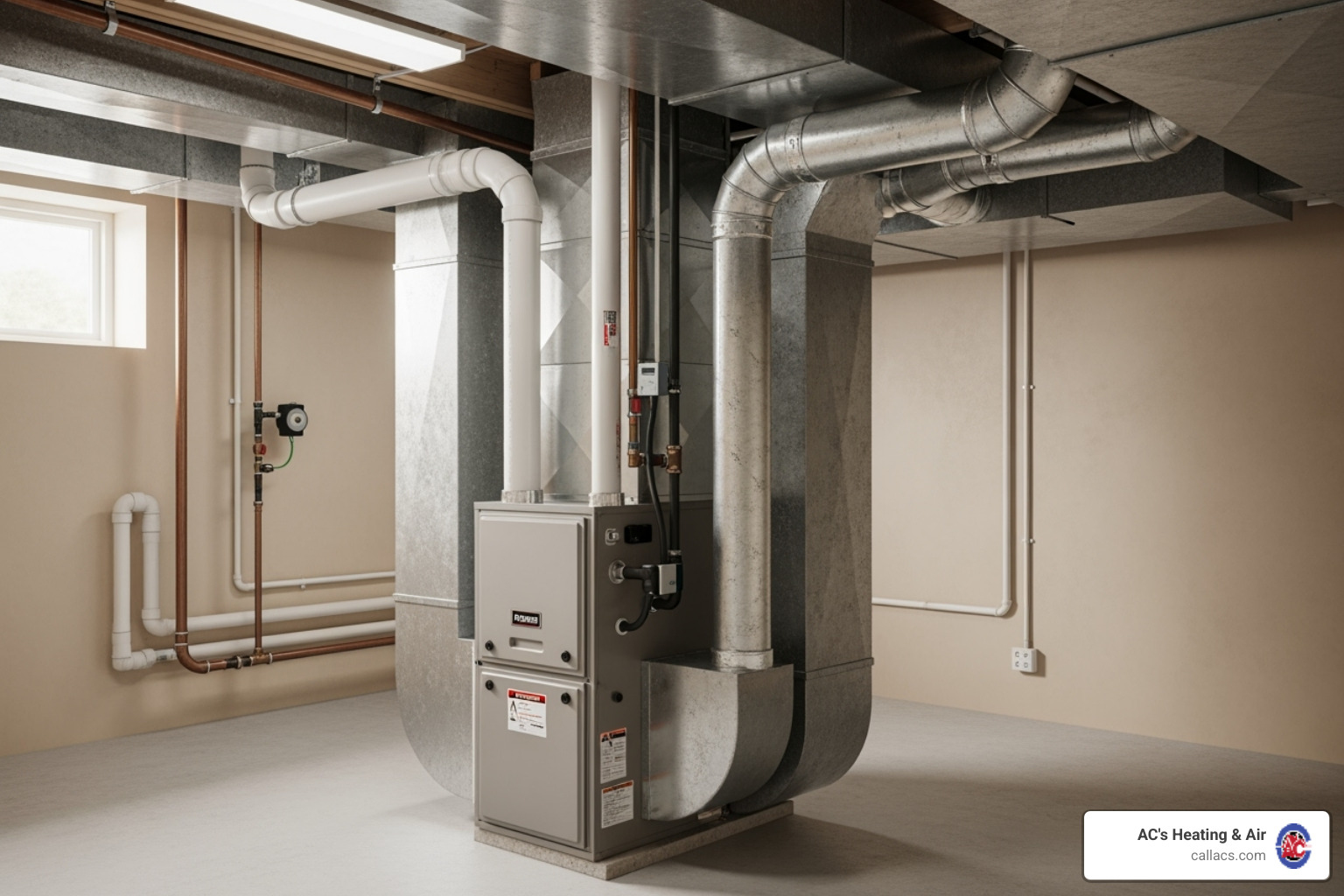No Heat, No Problem—Your Guide to Fixing a Furnace That Won't Warm Your Home

Your Home Feels Cold? Here's Why Your Furnace Might Not Be Warming It
If your furnace not warming house is leaving you shivering, you're not alone. It's a frustrating situation to have your furnace running, yet your home remains chilly. Before you panic, here are the most common reasons your furnace might not be heating effectively:
- Dirty Air Filter: This is the most common problem. A clogged filter blocks airflow.
- Thermostat Issues: Incorrect settings, dead batteries, or a faulty unit can prevent proper heating.
- Pilot Light or Ignition Problems: If the pilot light is out or the electronic igniter fails, your furnace won't produce heat.
- Blocked Vents or Ductwork: Restricted airflow from vents or leaky ducts means heat isn't reaching your rooms.
- Short Cycling: The furnace turns on and off too often without fully heating your home.
Imagine the chill of a winter night, and your heating system just isn't doing its job. This common problem can be caused by various issues, some simple to fix, others needing expert attention. We're here to help you understand what's going on.
I'm Allen Chenault, owner of AC's Heating & Air. With over 8 years in the HVAC industry, I've seen countless cases of furnace not warming house and am dedicated to providing reliable solutions.
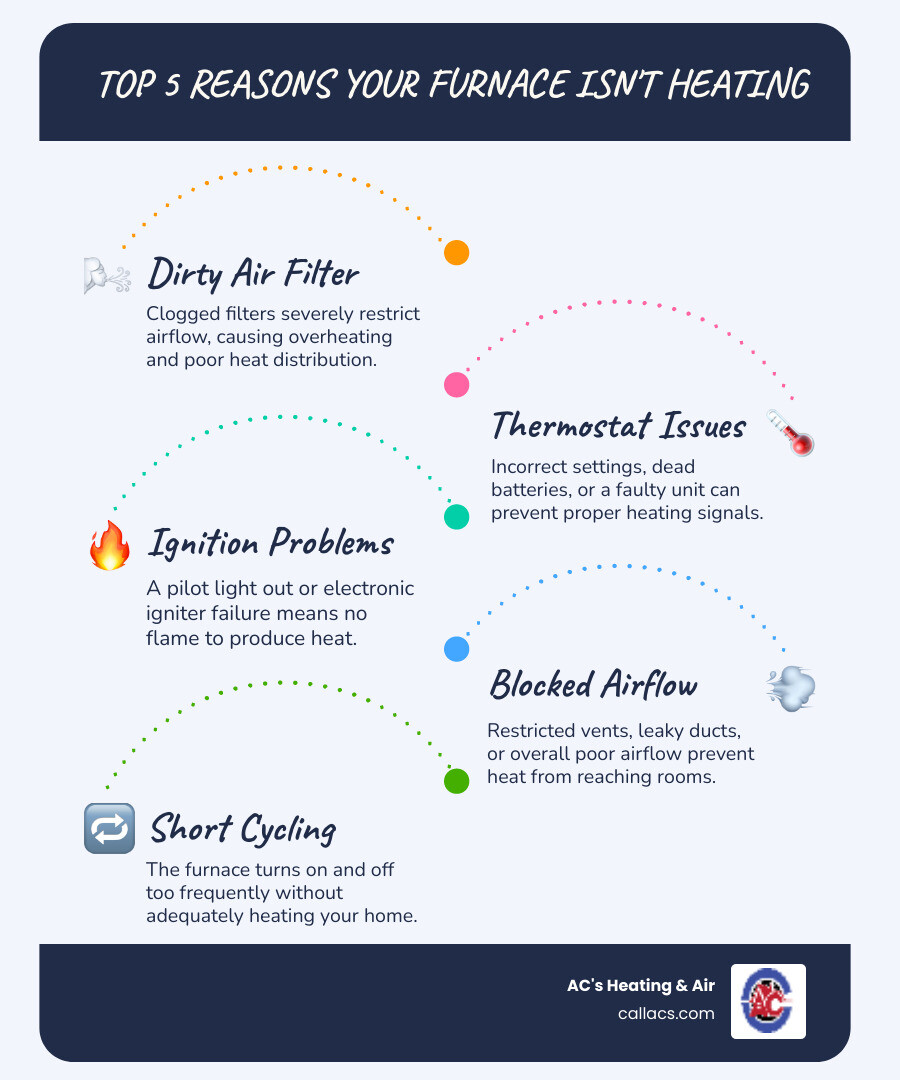
Start Here: Simple DIY Checks Before You Call for Help
When your furnace not warming house leaves you bundled up indoors, don't immediately reach for the phone. Many heating issues have surprisingly simple solutions you can tackle yourself. These basic checks can save you time and money, as about half of service calls could be avoided with these steps.
Checking Your Thermostat: The Brain of Your System
Your thermostat is the command center for your heating system. First, ensure it's set to \"Heat\" mode and the temperature is set higher than the current room temperature. A common mistake is the fan setting: use \"Auto,\" not \"On.\" \"Auto\" runs the fan only during heating cycles, while \"On\" runs it constantly, circulating unheated air that can make your home feel cool. Also, check the batteries; dead or dying batteries can cause erratic behavior or stop it from working altogether. If you're dealing with a thermostat not working, fresh batteries are often a quick fix. For complex models like a Honeywell Pro Series Thermostat Not Working, check the manual after trying these simple steps.
The Most Common Culprit: A Dirty Air Filter
If I had a dollar for every time a dirty air filter was the reason for a furnace not warming house complaint, I'd be retired. It's the most common problem we see and the easiest to fix.
Why Your Furnace Not Warming House is a Common Problem: Deeper Issues
If the quick fixes didn’t work, the trouble usually lies in one of three areas: (1) the unit short cycles, (2) warm air can’t travel through the ducts, or (3) the burners won’t ignite.
Short cycling means the furnace switches on, runs a minute or two, then shuts down before completing a full heat cycle. It can be caused by an oversized system, a faulty thermostat, or safety controls reacting to overheating. Besides leaving you cold, it puts heavy wear on parts and spikes energy bills.
Troubleshooting a Furnace Not Warming House Due to Airflow Issues
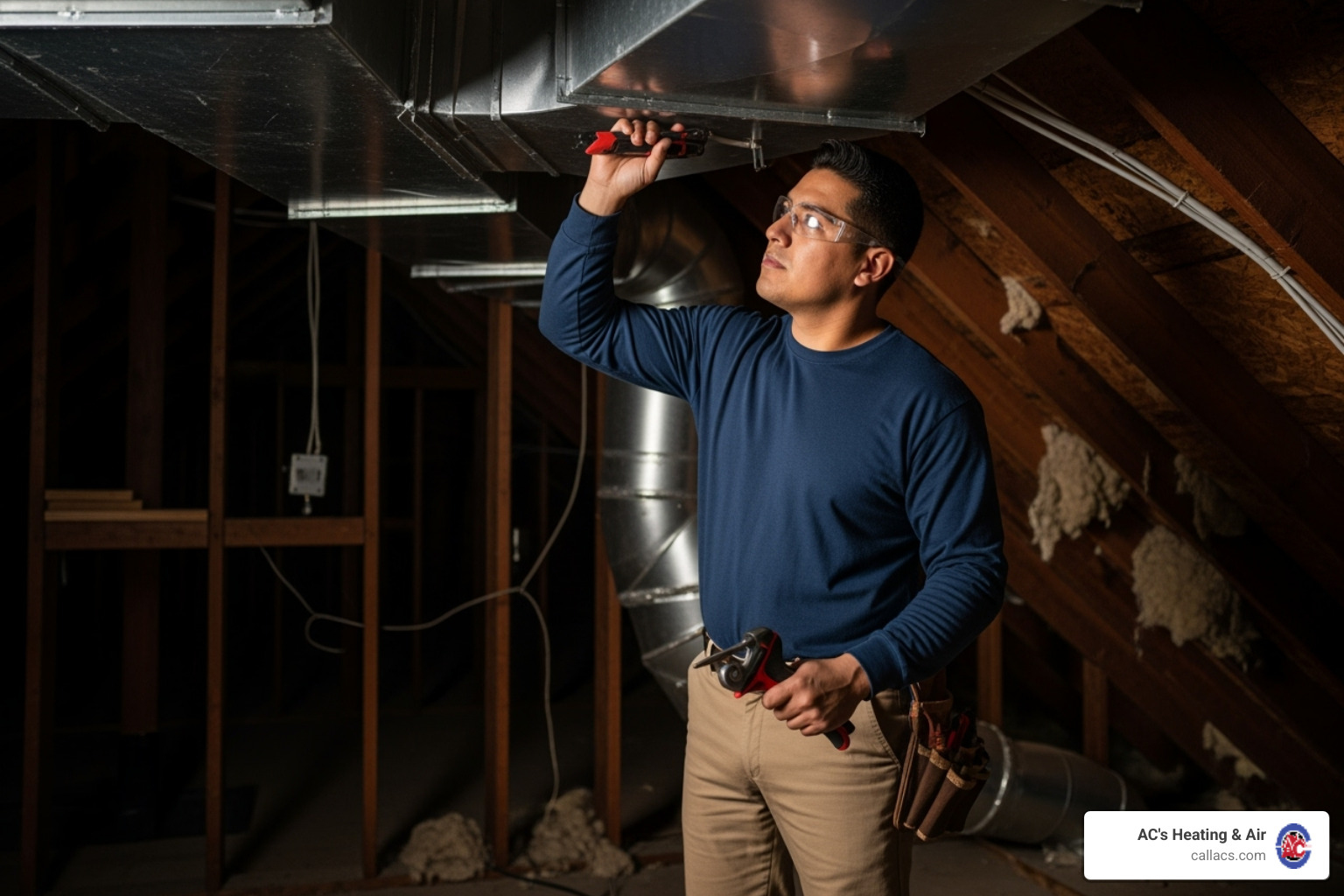
Leaky ducts, blocked registers, or a weak blower motor prevent heated air from reaching your rooms. The Department of Energy notes that duct leaks can waste 20–30 % of your heating energy, so sealing and insulating ducts is a fast comfort boost. On high-efficiency models, a clogged condensate drain can also shut the system down until it’s cleared.
If you’re battling uneven temperatures, our guide on How Do You Fix Uneven Heating in a House offers more tips.
What to Do When Your Furnace Not Warming House is an Ignition Problem
No flame, no heat. Older units rely on a pilot light; newer ones use an electronic igniter. A dirty flame sensor lets the burners ignite for a second, then shuts them off, while clogged burners starve the flame. Smell gas? Leave the house immediately and call the utility company—safety first.
Additional help: Electric Heater Blowing Cold Air in House and Furnace Doesn't Blow Hot Air.
Understanding Serious Mechanical Failures
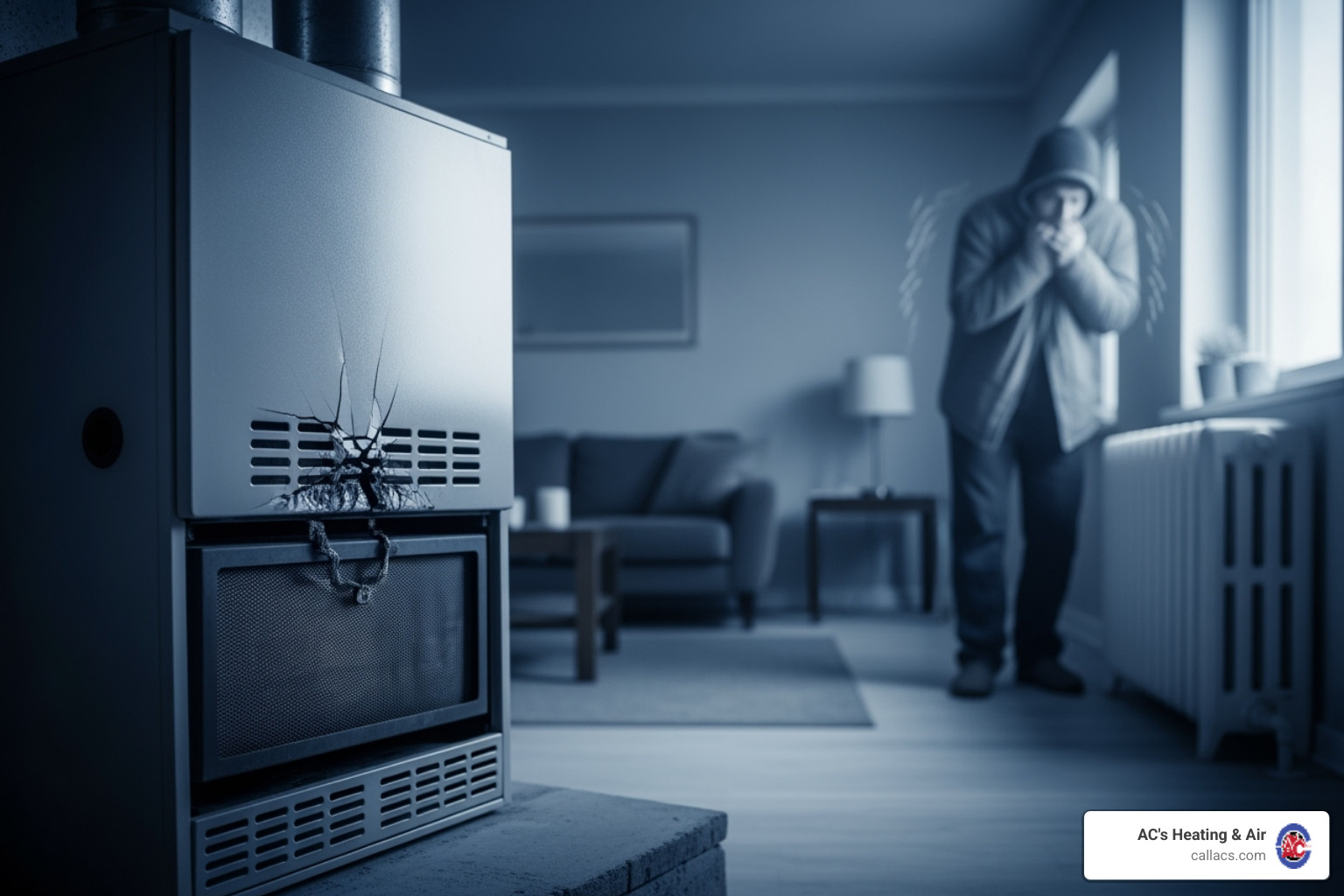
A cracked heat exchanger can leak carbon monoxide and usually means replacement. Loud grinding or squealing from the blower motor, or repeated overheating, are also signs of imminent failure. For urgent problems, we offer Emergency Furnace Repair.
Is It Time for a New Furnace? Repair vs. Replacement
When your furnace not warming house becomes a recurring nightmare, you might find yourself asking a bigger question: "Should I keep fixing this thing, or is it time to start fresh?" Trust me, you're not alone in this dilemma. After eight years in the HVAC business, I've had this conversation with countless homeowners who are tired of throwing money at an old, cranky furnace.
The age of your furnace is the first big clue. Most furnaces have a lifespan of 15 to 20 years, and once they hit that milestone, they're like that old car that starts needing more and more repairs. Those older units were built tough, but they're also energy hogs compared to today's efficient models.
Here's a handy rule we use in the industry: the "50% rule." If your repair costs are hitting 50% or more of what a new furnace would cost, it's time to seriously consider replacement. Think of it this way – you wouldn't keep pouring money into a car that needs a new transmission when you could get a reliable new one for just a bit more, right?
Energy efficiency is where modern furnaces really shine. Today's units have much higher AFUE ratings (Annual Fuel Utilization Efficiency), which means they convert more of their fuel into actual heat for your home instead of wasting it. Even here in Central Florida, where we don't use our heating systems as much as up north, those efficiency gains add up over time.
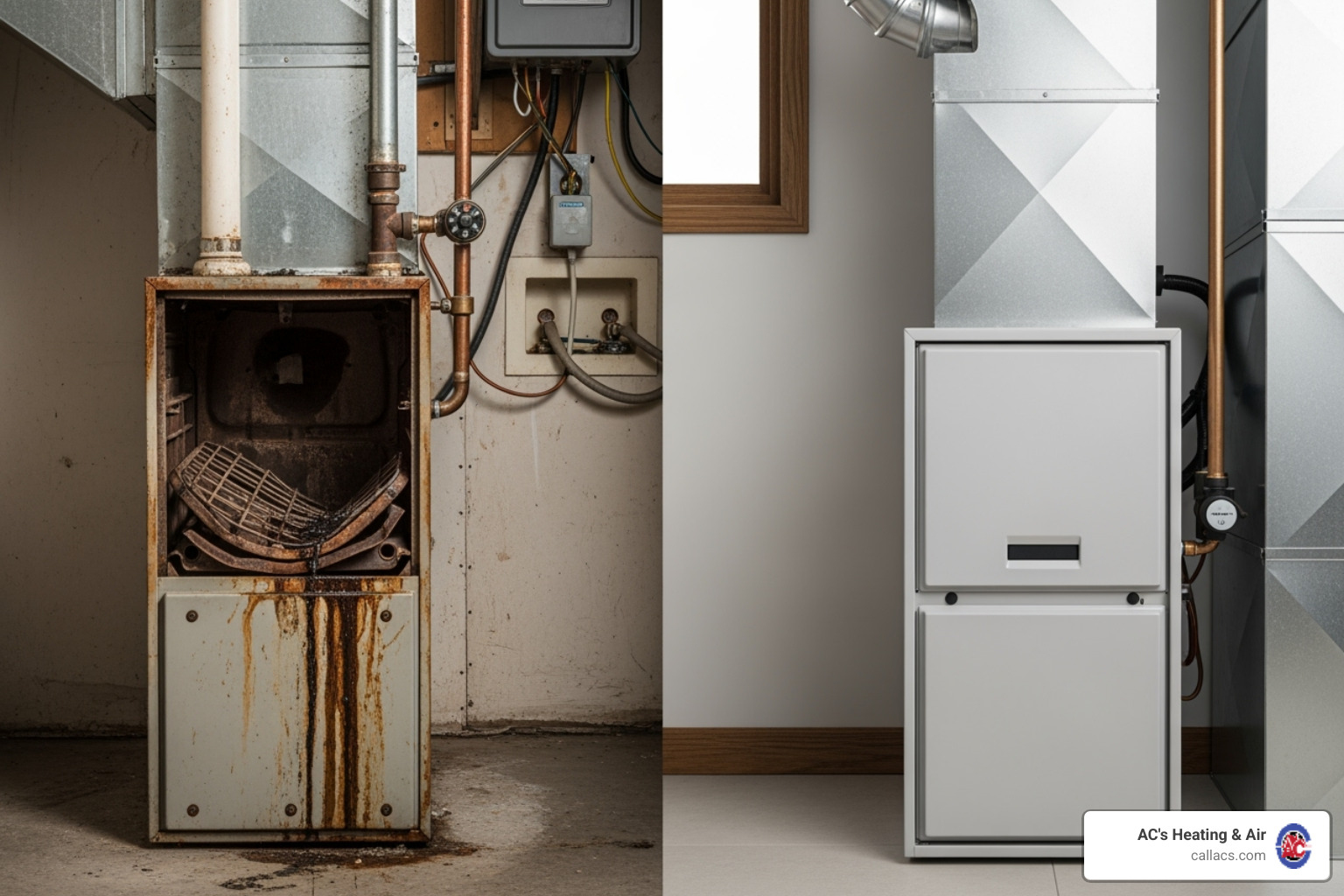
If you're dealing with rising energy bills, frequent breakdowns, or that frustrating situation where some rooms are toasty while others feel like ice boxes, these are all signs pointing toward replacement. A new furnace gives you a fresh start with modern technology, better reliability, and the peace of mind that comes with a full warranty.
The decision isn't always black and white, though. Sometimes a simple repair on a relatively young furnace makes perfect sense. But when you're facing major component failures on an older unit, or when you're calling for service multiple times a season, replacement often becomes the smarter financial choice. If you're ready to explore your options, our Furnace Installation Services can help you find the right solution for your home and budget.
The Power of Prevention: How Regular Maintenance Keeps You Warm
Imagine never having to ask, "Why is my furnace not warming house?" again. It sounds like a dream, right? Well, that's where regular, professional furnace maintenance comes in! Think of it as your heating system's annual check-up. It's the absolute best way to keep your furnace happy and healthy, preventing those chilly surprises before they even start.
So, what happens during an annual tune-up? A certified HVAC technician (like our friendly team at AC's Heating & Air!) will give your system a thorough once-over. They'll carefully inspect all the important parts, clean away any gunk or dust, make sure everything is properly lubricated, and check all the electrical connections. They'll also ensure your furnace is getting good airflow and burning fuel correctly. This proactive care is truly worth its weight in gold.
This simple annual visit brings a lot of amazing benefits. For starters, you'll notice Improved Efficiency. A well-maintained furnace doesn't have to work as hard, meaning it uses less energy to heat your home. That translates directly into lower energy bills for you! Plus, regular care helps your furnace last much longer, giving it a Longer Lifespan. Furnaces typically last 15 to 20 years, and good maintenance helps them reach the higher end of that range.
One of the biggest advantages is Preventing Breakdowns. Many common issues, like a dirty filter or a small component problem, can be spotted and fixed during maintenance. This stops them from turning into major, expensive breakdowns when you least expect them. And most importantly, regular tune-ups ensure Improved Safety. Technicians specifically check for dangerous issues like carbon monoxide leaks, keeping your home and family safe. Did you know that many manufacturer warranties also require proof of Warranty Protection through annual professional maintenance to stay valid? It's true!
Here in Central Florida, our Florida HVAC needs are a bit unique. While we don't have super long, harsh winters, our heating systems still need to be ready when the cooler weather hits. Our systems often work overtime during the long cooling season, so ensuring they're primed for heating season is crucial. Regular maintenance also plays a big role in humidity control, which is a year-round concern in our lovely climate.
Our Furnace Maintenance Services are designed to keep your system in tip-top shape, so you have reliable heat exactly when you need it. Investing a little now can save you a lot later on, making those future heating repairs much more Affordable Heating Repair.
Frequently Asked Questions about Furnace Heating Problems
It's completely normal to have questions when your heating system isn't behaving as it should. We hear a lot of inquiries from our wonderful customers about why their furnace not warming house effectively. Let's tackle some of the most common ones, along with our expert answers, to help you feel warm and informed.
Why is my furnace running but the house is still cold?
Ah, the classic mystery: your furnace is humming along, but you're still bundled up in blankets. This scenario tells us your furnace is trying, but the heat isn't making its way to you, or perhaps isn't being produced at all.
Often, this comes down to airflow issues. Imagine trying to blow through a straw that's clogged – not much air gets through, right? A severely dirty air filter is a prime suspect, as it chokes off the air your furnace needs to distribute heat. Similarly, blocked return or supply vents in your home, or even leaky ductwork in your attic or crawl space, can mean the warm air is getting lost before it reaches your living spaces. Your furnace might be generating heat, but it’s essentially getting trapped or escaping elsewhere.
Another common culprit is your thermostat. If the thermostat fan is set to "ON" instead of "AUTO," the blower will run continuously, even when the furnace isn't actively heating. This just circulates unheated air, making you think your furnace is blowing cold, when it's really just moving room-temperature air.
Sometimes, the problem isn't a malfunction but a mismatch. An undersized furnace might just not have enough power to heat your home adequately, especially on those colder Florida nights. It could run constantly but never quite reach the desired temperature. Lastly, don't overlook your home's own defenses against the cold: poor insulation, drafty windows and doors, or even blocked external air intakes can cause significant heat loss, making it feel like your furnace is failing even when it’s working perfectly.
For even more insights into this puzzling problem, you can read our detailed guide on Furnace Not Heating Home.
What is furnace 'short cycling' and what does it mean?
"Short cycling" sounds a bit like your furnace is on a coffee break, constantly turning on and off. And in a way, it is! When your furnace short cycles, it means it turns on for a very brief period – often just a few minutes – then shuts off before completing a full heating cycle. Annoyingly, it then turns back on shortly after, repeating this stop-and-go pattern. Your home never quite gets warm, and your furnace sounds like it’s having a minor tantrum.
This behavior is a big red flag that something isn't right with your system. One of the most frequent reasons for short cycling is overheating. Dirty air filter we talked about? It's a prime culprit here too! When airflow is restricted, your furnace gets too hot, and its built-in safety limit switch kicks in to prevent damage, shutting the burners down. Once it cools down, it tries to start again, leading to that frustrating short cycle.
Believe it or not, an improperly sized furnace can also cause short cycling. If your furnace is too powerful for your home, it can heat the space super quickly, satisfy the thermostat, and then shut off before the heat has a chance to properly spread out. This leads to uneven heating and puts extra wear and tear on your furnace's parts. Thermostat issues can also play a role, perhaps misreading the room temperature or being located in a drafty spot, causing the furnace to turn on and off too frequently. And sometimes, ignition problems can lead to short cycling if the furnace struggles to light, attempts to start, fails, and then tries again.
Short cycling wastes energy, puts unnecessary strain on your furnace's components, and can significantly shorten its lifespan. If you notice your furnace doing this, it’s definitely a sign that your system needs attention.
When is it absolutely necessary to call a professional?
While we love empowering homeowners with DIY troubleshooting tips, there are certain situations where picking up the phone to call a professional HVAC technician isn't just a good idea – it's absolutely crucial for your safety and the health of your home. Please, never hesitate to call an expert if you encounter any of the following:
First and foremost, your safety comes first. If you ever detect a gas smell (often described as rotten eggs) near your furnace or anywhere in your home, this is an emergency. Do NOT try to troubleshoot or fix it yourself. Immediately turn off your home's natural gas supply (if you know how to do so safely), evacuate everyone from your home, and then call your gas provider and emergency services from a safe location. Do not use any electrical devices, including light switches, as they could spark and ignite the gas.
Similarly, if your carbon monoxide detector alarms, or if you or family members start experiencing symptoms like headaches, nausea, dizziness, or fatigue (which can indicate CO poisoning), get fresh air immediately and call emergency services. Carbon monoxide is a silent killer, and this is not a situation to take lightly.
Any electrical issues like sparks, burning plastic smells, or frequently tripped breakers specifically related to your furnace are also clear signs to call a professional. Electrical problems can be dangerous and are best handled by trained experts. If a technician diagnoses a cracked heat exchanger, this is a serious safety hazard due to the risk of carbon monoxide leaking into your home. Replacement is typically the only safe solution, and it is NOT a DIY fix.
Finally, if you've done all the basic DIY checks and your furnace not warming house issue persists, or if you suspect a major component failure like the blower motor, control board, or gas valve, these are complex repairs that require specialized tools and expertise. It's time to call in the pros. We recommend finding a trusted NATE-certified HVAC technician who has proven knowledge and skills.
Your family's safety is our highest priority. For critical issues, especially those involving gas or carbon monoxide, please don't delay. Our Heater Repair Orlando FL team is always ready to assist you safely and efficiently.
Stay Warm and Safe with Expert Help
Nobody should have to endure a cold home, especially when your furnace not warming house properly. Throughout this guide, we've covered the journey from simple fixes to complex problems that require professional attention.
We started with the basics – checking your thermostat settings, replacing that dirty air filter, and ensuring your furnace has power and fuel. These simple steps can often resolve the issue quickly and save you money. But when the problem runs deeper, we explored airflow restrictions from leaky ductwork, ignition failures, and serious mechanical problems like cracked heat exchangers.
The key takeaway? While many furnace issues have straightforward solutions, safety always comes first. If you smell gas, suspect carbon monoxide, or encounter electrical problems, don't hesitate to call for help immediately. These situations demand professional expertise and should never be DIY projects.
Prevention is your best friend. Regular maintenance catches problems before they leave you shivering and extends your furnace's life significantly. It's a small investment that pays dividends in comfort, safety, and peace of mind.
When DIY troubleshooting reaches its limits, or when safety concerns arise, that's where we come in. At AC's Heating & Air, we've been helping Central Florida families stay comfortable for years. Our team understands the unique heating needs of our climate and communities.
We're proud to serve Apopka, Winter Park, Orlando, Winter Garden, and surrounding areas. Whether you need emergency repairs, routine maintenance, or a complete furnace replacement, we're here to help you get back to enjoying a warm, comfortable home.
Don't let a chilly house disrupt your family's comfort any longer. Contact us for professional furnace repair services and let our experienced technicians restore the warmth to your home quickly and safely.

